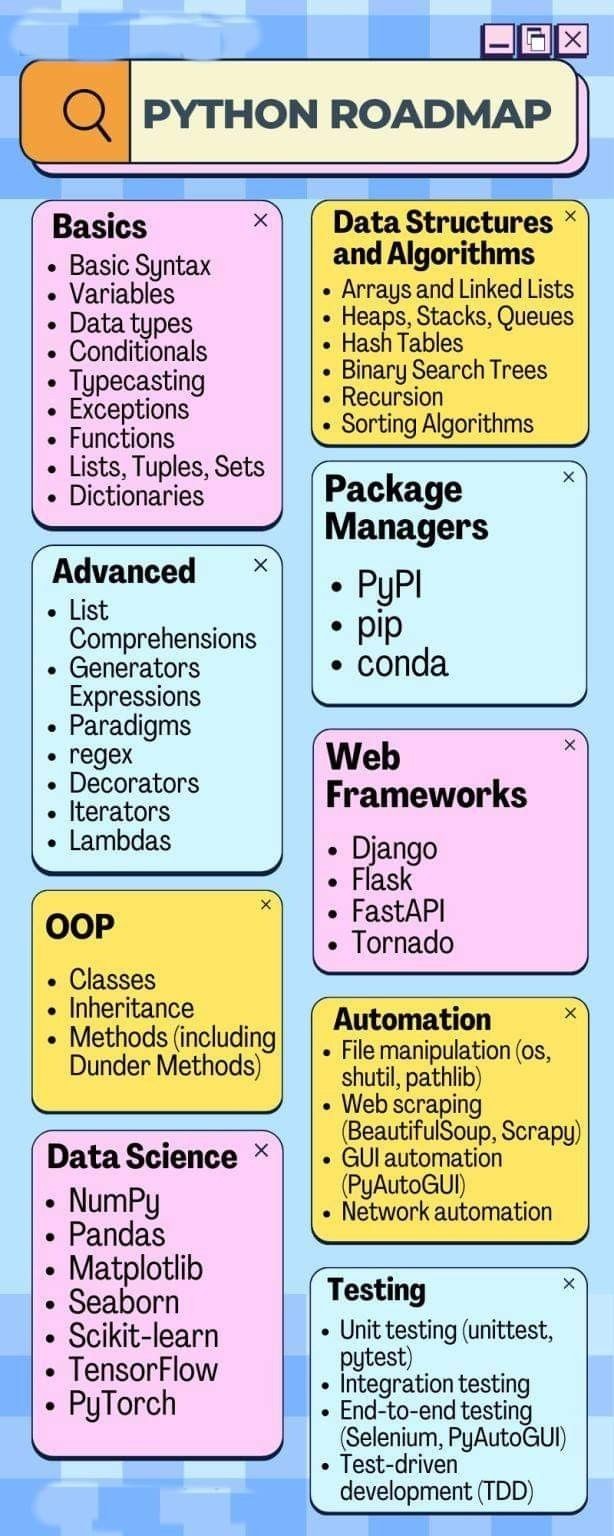Your Curated Tumblr Experience Awaits!
Programmierung - Blog Posts
Python’s List Comprehension ...

List comprehension in Python is a way to create lists using a compact and concise syntax. It’s like a shortcut for making lists by applying an operation to each item in another list or sequence. Instead of writing a loop, you can use a single line of code to generate a new list.
- The Python Nerd -
Post#159: Medium, The Python Nerd, Mastering Python's List Comprehension, 2025.

Post#155: Runestone, OpenBookProject.Net, Strings Are Objects, 2025.
Studyflix - "Unified Modeling Language" ...

Post #150: StudyFlix, UML, Was ist Unified Modeling Language?, 2024.
Mein 666-Tage-Lauf bei SoloLearn ...

Mein momentaner Programmierkurs ...

Post #149: SoloLearn, Learn To Code, Tutorial: Grundlagen der Programmierung (Python, HTML & CSS, SQL), 2024.
Built-In Data Types As Objects In Python ...

Post #108: W3Schools, Built-in data types in Python, 2023.
Python Tutorial #24 Methoden in Klassen ...
Das ist das letzte Video des Python Tutorials von "Programmieren-Starten". Wer tiefer in die Programmierung mit Python einsteigen möchte, dem kann ich den "Masterkurs" von "Programmieren-Starten" empfehlen, den ich auch komplett durchgearbeitet habe.

Post #93: YouTube, Programmieren Starten, Python Tutorial, #24/24 Methoden in Klassen, 2023.

Post #91: Pinterest, @usamaawan5752, Python Road Map, 2023.
Post #90: The pillars of object-oriented programming: Object, Class, Inheritance, Polymorphism, Abstraction and Encapsulation, 2023.
The concept of object oriented programming explained
Object-oriented programming is a fundamental concept present in numerous programming languages such as C++, Java, JavaScript, and more. It becomes straightforward once you truly grasp it, and that's precisely what this post aims to help you achieve. So, stop your scrolling for a second and delve into this post for a thorough and clear explanation.

Understanding the Term "Object-Oriented"
To grasp OOP, let's begin by explaining the name itself: "Object-Oriented." This term signifies that OOP revolves around entities known as "objects."
What Exactly Is an Object?
An object in OOP is any entity that possesses both state and behavior. Consider a dog as an example: it has states such as color, name, and breed, while its behaviors encompass actions like wagging the tail, barking, and eating.
The reason we introduce the concept of objects in programming is to effectively represent real-world entities, a task that cannot be accomplished with conventional variables or arrays.
Classes: Abstract Forms of Objects
Now, what about classes? A class is essentially the abstract form of an object. If we take the example of a "dog," the object "Mydog" is a concrete instance, while the class "dog" represents dogs in a more general sense. Think of a class as a blueprint or template from which you can create individual objects.
Four Pillars of Object-Oriented Programming
Now that we've established the fundamentals of objects and classes. OOP is built upon four key principles:
Inheritance: Inheritance occurs when one object inherits all the properties and behaviors of a parent object. It promotes code reusability and facilitates runtime polymorphism.
Polymorphism: Polymorphism entails performing a single task in multiple ways. For instance, it can involve presenting information differently to customers or implementing different shapes like triangles or rectangles.
Abstraction: Abstraction is about concealing internal details while exposing functionality. Consider a phone call; we don't need to understand the intricate inner workings.
Encapsulation: Encapsulation involves bundling code and data into a single unit. Just like a capsule contains various medicines . In a fully encapsulated class (e.g., a Java bean), all data members are private, ensuring data integrity and controlled access.
I remember finding these images that explained these concepts using the 'Squid Game' series, and they are just perfect. So, I'm sharing them here and giving all credit to their owner :
Polymorphism , Inheritance , Encapsulation
Python Tutorial #23 Der Self-Parameter ...
Post #89: YouTube, Programmieren Starten, Python Tutorial, 23/24 Der "Self" Parameter, 2023.
Microsoft Visual Studio Code ...

Post #26: Computer Bild, Microsoft Visual Studio Code, Tutorial zur Programmierumgebung (IDE), 2023.